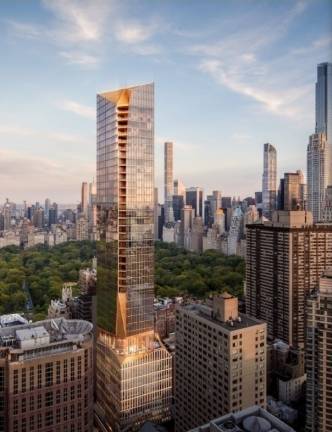City cracks down on building voids

By Michael Garofalo
The City Council last week voted by a 47-1 margin to enact a long-awaited zoning change that will place new limits on the use of mechanical voids — a controversial development practice which some builders have utilized to inflate tower heights through the use of largely empty spaces.
The measure tightens a so-called zoning loophole that exempts spaces designated for mechanical use from the floor area calculations that in many districts effectively govern a building’s maximum permissible height. In recent years, a number of developers had exploited the fact that these mechanical spaces were not subject to height restrictions by designing buildings with tall voids in their middle sections. Such spaces ostensibly hold mechanical equipment but primarily serve to enhance the views and price tags of residential units on the floors above.
The zoning text amendment approved by the Council at its May 29 meeting will limit mechanical voids to 25 feet in height; spaces exceeding 25 feet will count toward a project’s buildable floor area. In issuing its approval, the Council modified the amendment to tighten earlier language proposed by the City Planning Commission that would have permitted voids up to 30 feet tall.
Developers will be permitted to claim the exemption for multiple mechanical voids within a building, provided that each void space is separated by at least 75 feet in vertical distance.
“We’re saying no to empty buildings filled with voids simply to give the one-percent better views while leaving the rest of us in their shadow,” said Upper East Side Council Member Ben Kallos, a longtime supporter of efforts to address the voids loophole. “By strengthening and passing the proposal to limit the height of mechanical voids to 25 feet, we are taking a significant step forward toward stopping developers from getting around the zoning to give billionaires views instead of building affordable housing for New Yorkers.”
The new rules would effectively prevent developers from designing buildings like Extell Development’s controversial 775-foot tower now under construction at 36 West 66th St., which includes several tall mechanical spaces. Voids on the building’s 15th, 17th, 18th and 19th floors are 20, 64, 64 and 48 feet in height, respectively, and collectively account for more than a quarter of the building’s total height.
The Extell project is the subject of a pending zoning appeal and an ongoing lawsuit. The Department of Buildings issued permits for the building earlier this year, before the new void restrictions were approved.
For now, the zoning change approved by the Council applies only in certain residential zoning districts, primarily in Manhattan. The Department of City Planning plans to expand the scope of the void restrictions to other parts of the city through a second zoning text amendment to be proposed later this year. The amendment applies only to enclosed spaces, meaning that voids classified as outdoor space would be exempted.
Kallos and other members of the Council’s Manhattan delegation have vowed to pursue further changes to zoning law to address other perceived loopholes that have resulted in buildings taller than planners originally anticipated under the city’s 1961 Zoning Resolution, including unenclosed voids, excessive ceiling heights on non-mechanical floors, and so-called “gerrymandered” zoning lots.